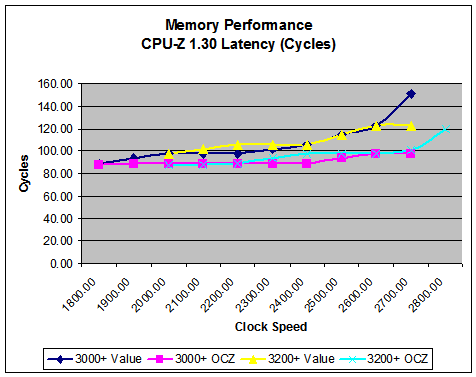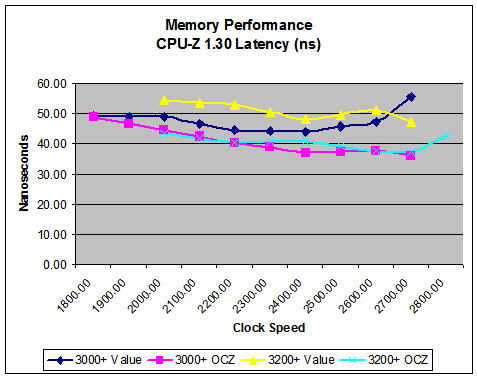Investigations into Socket 939 Athlon 64 Overclocking
by Jarred Walton on October 3, 2005 4:35 PM EST- Posted in
- CPUs
RAM Latency
We talked about memory latency a bit before, and we estimated the total latency. Using CPU-Z and the included Latency.exe utility, we can get an actual real value for memory latency - or at least, more real than our estimate. There are different ways of measuring memory latency, but we simply took the highest reported value from the table that was generated. For every system, that value was in the bottom-right corner of the table, indicating a data set of 32MB and a stride of 512. While the values may or may not be entirely accurate, they should at least be consistently measured across all the tested configurations. Here are the results, in CPU cycles as well as nanoseconds. Remember that at higher CPU speeds, each cycle is faster, so pay more attention to the nanoseconds graph.
While the value RAM is clearly slower than the expensive RAM, the big question is: how much performance do you actually lose by opting for more economical RAM? This is one of the areas that we are interested in testing for this article, and we'll comment on the results throughout the benchmarks.
RAM Possibilities
One area of the BIOS that's missing (for now) is support for additional RAM ratios. The reality is that the RAM speed is derived from the CPU clock with a divider. Ideally, we'd like to see a BIOS that gives direct access to the CPU divider rather than hiding it behind approximate memory speeds. That would allow for the selection of a larger range of options, but we're not sure if that's something that AMD controls in the CPU or if the BIOS programmers can do this. Here's a list of the standard RAM Settings, CPU multipliers and the resultant memory dividers that were available in the Infinity BIOS.
We have a LanParty UT nF3 250Gb that includes support for many in-between options from DDR200 through DDR500. Some of the interesting inclusions are DDR240, DDR280, DDR300, DDR360, DDR440, and DDR500. (CPU-Z actually failed to report the divider on a couple of those settings, but the resultant RAM speed was still read properly.) While additional memory dividers on the high end won't really help tweakers looking to get the most from the TCCD, BH5, or CH5 RAM, they can be particularly useful when using value RAM. All you need to do is select the appropriate divider to get your RAM under DDR400 - assuming standard value RAM. That way, you wouldn't take as much of a performance hit by running something like 10x250 (2.5 GHz). You could select a 13X divider rather than the standard 15X divider.
Additional ratios can even be useful for tuning performance RAM. For example, OCZ VX would not run stable above DDR500 (10x250), and we had to use 2-3-3-8-1T timings even then. (The 3.2V limit of the motherboard was at least partially to blame.) Running at 10x270, we had to drop to DDR333 (CPU/12), which resulted in the RAM running at DDR450 rather than the DDR540 result that would have been required for the normal CPU/10 ratio. However, if we could have selected a CPU/11 ratio, we could have run the RAM at DDR490 and gained a bit more performance. The additional ratios aren't required, but they would be nice to have.
If the last two paragraphs didn't make sense, then you can guess why we don't get additional access to RAM dividers. Experienced users might know how to make use of the settings, but many people would simply get confused; a "Catch-22".
We talked about memory latency a bit before, and we estimated the total latency. Using CPU-Z and the included Latency.exe utility, we can get an actual real value for memory latency - or at least, more real than our estimate. There are different ways of measuring memory latency, but we simply took the highest reported value from the table that was generated. For every system, that value was in the bottom-right corner of the table, indicating a data set of 32MB and a stride of 512. While the values may or may not be entirely accurate, they should at least be consistently measured across all the tested configurations. Here are the results, in CPU cycles as well as nanoseconds. Remember that at higher CPU speeds, each cycle is faster, so pay more attention to the nanoseconds graph.


While the value RAM is clearly slower than the expensive RAM, the big question is: how much performance do you actually lose by opting for more economical RAM? This is one of the areas that we are interested in testing for this article, and we'll comment on the results throughout the benchmarks.
RAM Possibilities
One area of the BIOS that's missing (for now) is support for additional RAM ratios. The reality is that the RAM speed is derived from the CPU clock with a divider. Ideally, we'd like to see a BIOS that gives direct access to the CPU divider rather than hiding it behind approximate memory speeds. That would allow for the selection of a larger range of options, but we're not sure if that's something that AMD controls in the CPU or if the BIOS programmers can do this. Here's a list of the standard RAM Settings, CPU multipliers and the resultant memory dividers that were available in the Infinity BIOS.
| Standard AMD Memory Ratios | |||
| RAM Setting | CPU Multiplier | RAM Divider | True RAM Speed |
| DDR200 | 9X | CPU/18 | DDR200 |
| DDR266 | 9X | CPU/14 | DDR257 |
| DDR333 | 9X | CPU/11 | DDR327 |
| DDR400 | 9X | CPU/9 | DDR400 |
| DDR200 | 10X | CPU/20 | DDR200 |
| DDR266 | 10X | CPU/15 | DDR267 |
| DDR333 | 10X | CPU/12 | DDR333 |
| DDR400 | 10X | CPU/10 | DDR400 |
| DDR200 | 11X | CPU/22 | DDR200 |
| DDR266 | 11X | CPU/17 | DDR259 |
| DDR333 | 11X | CPU/14 | DDR314 |
| DDR400 | 11X | CPU/11 | DDR400 |
| DDR200 | 12X | CPU/24 | DDR200 |
| DDR266 | 12X | CPU/18 | DDR267 |
| DDR333 | 12X | CPU/15 | DDR320 |
| DDR400 | 12X | CPU/12 | DDR400 |
We have a LanParty UT nF3 250Gb that includes support for many in-between options from DDR200 through DDR500. Some of the interesting inclusions are DDR240, DDR280, DDR300, DDR360, DDR440, and DDR500. (CPU-Z actually failed to report the divider on a couple of those settings, but the resultant RAM speed was still read properly.) While additional memory dividers on the high end won't really help tweakers looking to get the most from the TCCD, BH5, or CH5 RAM, they can be particularly useful when using value RAM. All you need to do is select the appropriate divider to get your RAM under DDR400 - assuming standard value RAM. That way, you wouldn't take as much of a performance hit by running something like 10x250 (2.5 GHz). You could select a 13X divider rather than the standard 15X divider.
Additional ratios can even be useful for tuning performance RAM. For example, OCZ VX would not run stable above DDR500 (10x250), and we had to use 2-3-3-8-1T timings even then. (The 3.2V limit of the motherboard was at least partially to blame.) Running at 10x270, we had to drop to DDR333 (CPU/12), which resulted in the RAM running at DDR450 rather than the DDR540 result that would have been required for the normal CPU/10 ratio. However, if we could have selected a CPU/11 ratio, we could have run the RAM at DDR490 and gained a bit more performance. The additional ratios aren't required, but they would be nice to have.
If the last two paragraphs didn't make sense, then you can guess why we don't get additional access to RAM dividers. Experienced users might know how to make use of the settings, but many people would simply get confused; a "Catch-22".










101 Comments
View All Comments
DonTrowbridg3 - Thursday, October 4, 2018 - link
2018 checking in. Thanks for all the info and comments. Very helpful in overclocking my FX-60, A8N32-SLI, dual 8800 GTX